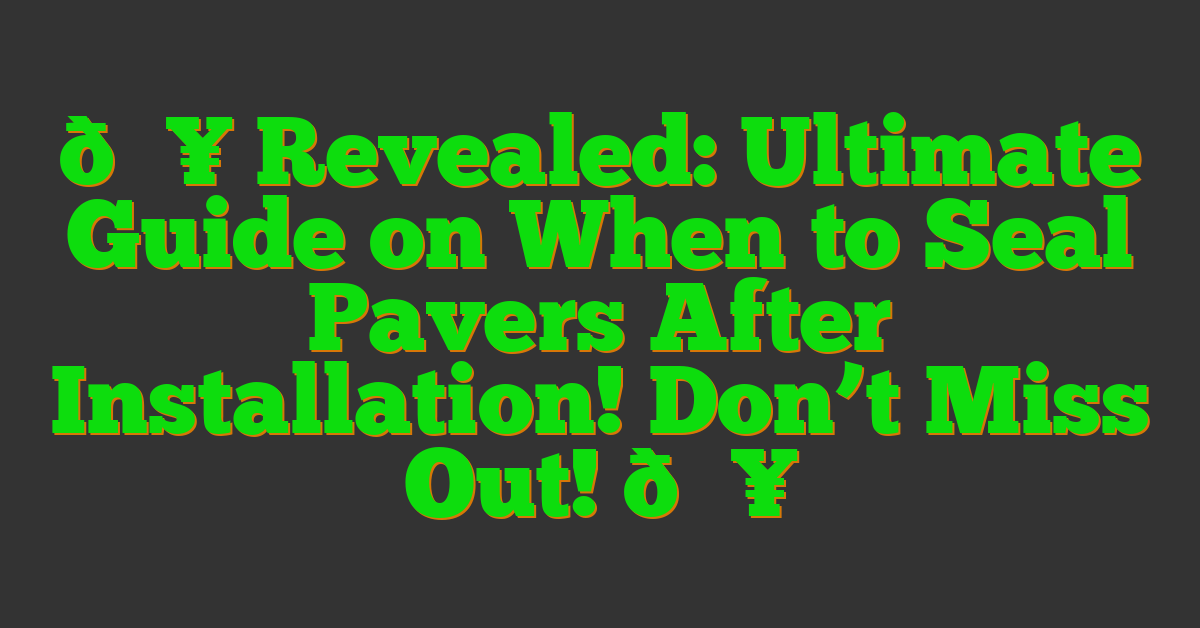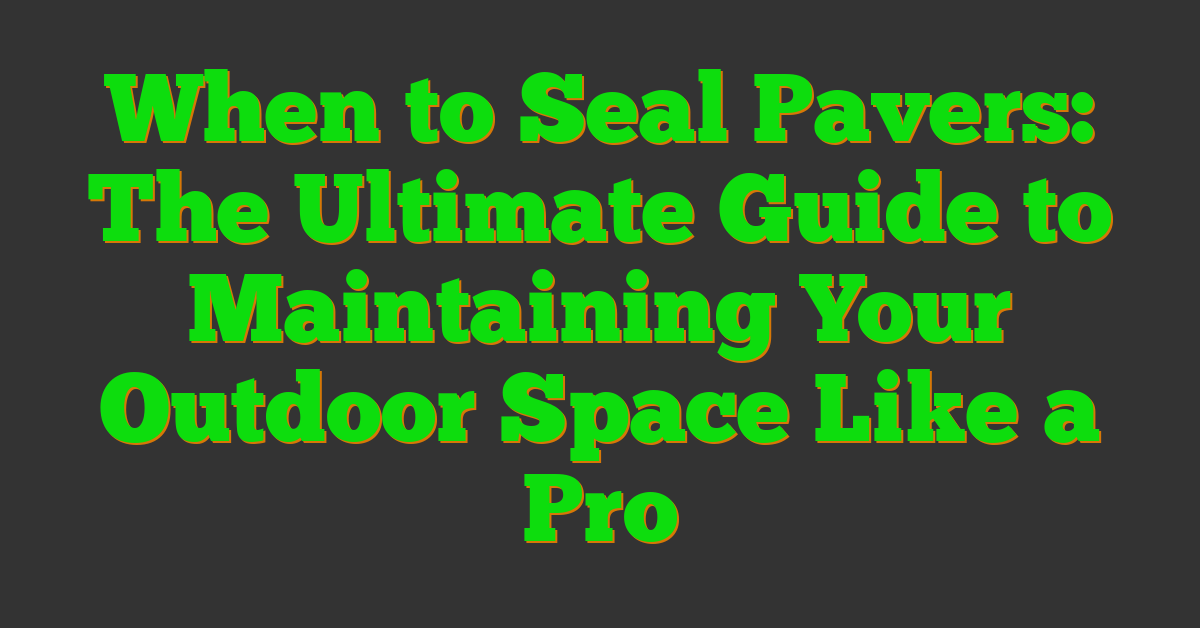So, you’ve just had those beautiful pavers installed, transforming your outdoor space into a stunning oasis. But when should you seal them to ensure they stay looking pristine for years to come? Well, we’ve got you covered. Sealing pavers is a crucial step in protecting them from the elements and maintaining their appearance.

After all the hard work of installation, it’s essential to know the right timing for sealing to maximize the benefits. In this article, we’ll walk you through the optimal timeframe for sealing your pavers post-installation. Let’s dive in and make sure your pavers stay as gorgeous as the day they were laid.
Understanding the Purpose of Sealing Pavers
As landscape designers, we know that sealing pavers is crucial for enhancing their longevity and appearance. Let’s delve into why sealing your pavers is a smart move:
The Benefits of Sealing Your Pavers
Sealing your pavers offers a myriad of advantages. Firstly, it acts as a protective shield against external elements such as UV rays, rain, snow, and even foot traffic. By creating a barrier on the surface, sealing helps prevent stains, mold, and weed growth, which can mar the beauty of your pavers over time.
Moreover, sealing enhances the color and texture of the pavers, giving them a vibrant and fresh look. It accentuates the natural hues of the stones, making them stand out and adding a touch of elegance to your outdoor space. Additionally, sealed pavers are easier to clean and maintain, saving you time and effort in the long run.
Potential Risks of Not Sealing Pavers
On the flip side, neglecting to seal your pavers can lead to several issues. Unsealed pavers are more susceptible to fading due to prolonged exposure to sunlight, losing their original charm and appeal. Without a protective seal, pavers are prone to absorbing liquids, resulting in stains that are tough to remove.
Furthermore, unsealed pavers are vulnerable to weed and moss growth between the joints, detracting from the neat, polished look of your outdoor area. The lack of a sealant also makes the pavers prone to erosion and surface damage, shortening their lifespan and requiring more frequent repairs or replacements.
Understanding these benefits and risks underscores the importance of timely sealing to preserve the beauty and durability of your pavers for years to come.
When to Seal Pavers After Installation
Assessing Weather Conditions and Timing
When it comes to determining the ideal time to seal pavers after installation, we place great importance on assessing the weather conditions. It’s crucial to choose a time when there is no chance of rain for at least 24 hours both before and after sealing. Sealing pavers during dry weather ensures proper adhesion and penetration of the sealant, enhancing its effectiveness in protecting the pavers from various elements.
The Role of Curing in the Sealing Process
In our experience as landscape designers, we understand the significance of curing in the sealing process. Before sealing pavers, we always allow an adequate curing period, typically around 30 days after installation. This curing time allows the pavers to settle, ensuring that they are completely dry and free from any moisture that could compromise the sealant’s adhesion and performance. By allowing sufficient curing time, we maximize the benefits of sealing in terms of protection and longevity for the pavers in outdoor spaces.
Choosing the Right Sealant for Your Pavers
Types of Paver Sealants
When it comes to protecting your pavers, selecting the appropriate sealant is crucial. There are primarily two types of paver sealants: film-forming and penetrating. Film-forming sealants create a protective layer on the surface of the pavers, offering enhanced color enhancement and protection against stains, UV rays, and water infiltration. On the other hand, penetrating sealants are absorbed into the pavers, providing protection without altering the appearance significantly. They are ideal for retaining the natural look of your pavers while offering protection against moisture and oil penetration.
How to Select the Best Sealant for Your Needs
To choose the best sealant for your pavers, consider the specific requirements of your outdoor space. If you prefer a glossy finish that enhances the colors of your pavers, a film-forming sealant would be suitable. However, if you want a more natural look while still ensuring protection, a penetrating sealant might be the better option. Additionally, factors such as the type of pavers, climate conditions, and foot traffic in the area should influence your decision. Consult with a professional landscape designer or supplier to determine the most suitable sealant that meets your needs and enhances the longevity of your outdoor pavers.
Preparing for the Sealing Process
Cleaning and Preparing the Surface
As landscape designers, we know that proper cleaning and preparation of the surface are essential steps before sealing pavers. Before starting the sealing process, we must ensure that the pavers are clean and free of any dirt, debris, or stains. We recommend starting with a thorough cleaning using a pressure washer to remove any stubborn grime or residues. It’s crucial to allow the pavers to dry completely before applying the sealant to ensure optimal adhesion and effectiveness.
Necessary Materials and Tools
When getting ready to seal pavers, having the necessary materials and tools at hand is vital for a successful sealing process. As professionals, we always ensure we have the following items ready:
- Sealant: Choose the appropriate sealant for your pavers based on factors such as finish, type of pavers, climate, and foot traffic.
- Application tools: Depending on the type of sealant chosen, you may need a brush, roller, or sprayer for the application.
- Safety gear: Don’t forget to wear protective gear such as gloves, goggles, and a mask to prevent direct contact with the sealant.
- Cleaning supplies: Prepare cleaning materials like a pressure washer, detergent, and scrub brush for thorough cleaning before sealing.
- Painter’s tape: Use painter’s tape to protect surrounding surfaces or edges that should not come into contact with the sealant.
By ensuring we have all the necessary materials and tools ready, we can streamline the sealing process and achieve optimal results in protecting and enhancing the appearance of outdoor pavers.
Step-by-Step Guide to Sealing Pavers
Applying the Sealant Evenly
When it comes to sealing pavers, ensuring an even application of the sealant is crucial to achieve optimal results. We recommend starting by carefully reading the manufacturer’s instructions on the sealant product you’ve chosen. These instructions typically provide specific guidance on application techniques, drying times, and coverage rates.
To apply the sealant evenly, we suggest using a suitable applicator, such as a paint roller or sprayer, depending on the size of the paver area. Begin by pouring the sealant in a small, manageable section of the pavers. Then, using the applicator, spread the sealant evenly across the surface, working in small, overlapping strokes to ensure thorough coverage.
Avoid applying the sealant too thickly, as this can lead to an uneven finish and potentially cause issues with drying and curing. It’s essential to maintain a consistent application rate to prevent streaks or puddles from forming on the pavers.
After completing the first section, continue applying the sealant in manageable parts until the entire paver surface is covered. Take care to work systematically and avoid stepping on freshly sealed areas to maintain an even finish across the entire surface.
« Pavers vs. Flagstone: The Shocking Truth About Which Will Break Your Bank Unveiling the Ultimate Showdown: Belgard vs Nicolock Pavers – Which Reigns Supreme for Your Outdoor Oasis? »
Ensuring Proper Drying and Curing Time
Once the sealant has been applied evenly to the pavers, the next critical step is to allow sufficient time for drying and curing. Proper drying and curing times are essential to ensure that the sealant effectively bonds with the paver surface and provides long-lasting protection.
We recommend checking the manufacturer’s instructions for specific drying and curing times, as these can vary depending on the sealant type and environmental conditions. In general, most sealants require at least 24 to 48 hours to dry completely before the paver surface can be used.
During the drying and curing process, it’s important to keep foot traffic and moisture away from the sealed pavers to prevent any disturbances to the sealant’s setting process. Additionally, avoid exposing the sealed pavers to heavy rainfall or extreme weather conditions during this critical period.
By allowing the sealant adequate time to dry and cure, you’ll ensure that your pavers are well-protected and maintain their appearance for years to come. Patience during this phase will be rewarded with a beautifully sealed paver surface that withstands the test of time.
Maintenance After Sealing Pavers
As landscape designers, we understand that maintaining the beauty and durability of your paved surfaces is crucial. After sealing your pavers, there are essential steps to follow to ensure they stay in optimal condition for years to come. Let’s dive into the necessary maintenance practices.
Regular Cleaning and Upkeep
After sealing your pavers, regular cleaning is key to preserving their appearance and longevity. We recommend sweeping the surface with a broom or using a leaf blower to remove dirt, debris, and organic materials like leaves. For a more thorough clean, washing the sealed pavers with a mild detergent and water can help remove any stubborn stains or grime. Avoid using harsh chemicals that can damage the sealer and the pavers themselves.
When to Reapply Sealant
Determining when to reapply the sealant on your pavers is essential for maintaining their protective layer. A general rule of thumb is to monitor the condition of your sealed pavers regularly. When you start noticing signs of wear and tear, such as fading color, reduced water beading, or increased susceptibility to stains, it’s time to consider resealing.
Regular foot traffic, exposure to harsh weather conditions, and the type of sealant used can all affect how often you need to reapply the sealant. In high-traffic areas or regions with extreme weather, you may need to reseal your pavers more frequently. Be proactive in inspecting your sealed pavers to catch any maintenance needs early on and protect your outdoor investment.
Conclusion
Sealing pavers is crucial for preserving their beauty and durability. By selecting the appropriate sealant and following proper maintenance, we can protect our outdoor investments. Regular cleaning and monitoring of sealed pavers help in detecting wear and tear early on, ensuring timely reapplication of sealant. By staying proactive and attentive, we can enjoy long-lasting protection for our outdoor pavers in any climate.
















